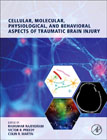
Cellular, Molecular, Physiological, and Behavioral Aspects of Traumatic Brain Injury
Rajendram, Rajkumar
Preedy, Victor R.
Martin, Colin R.
Traumatic brain injury has complex etiology and may arise as a consequence of physical abuse, violence, war, vehicle collisions, working in the construction industry, and sports. Cellular, Molecular, Physiological, and Behavioral Aspects of Traumatic Brain Injury will improve readers' understanding of the detailed processes arising from traumatic brain injury. Featuring chapters on neuroinflammation, metabolism, and psychology, this volume discusses the impact of these injuries on neurological and body systems to better understand underlying pathways. This book will be relevant for neuroscientists, neurologists, clinicians, and anyone working to better understand traumatic brain injury. Summarizes the neuroscience of traumatic brain injury, including cellular and molecular biology Contains chapter abstracts, key facts, dictionary, and summary points to aid in understanding Features chapters on signaling and hormonal events Includes plasticity and gene expression Examines health and stress behaviors after traumatic brain injury INDICE: Section 1. Setting the Scene: The Spectrum of Traumatic Brain Injuries1. Slips, falls and traumatic brain injury2. Road traffic accidents and traumatic brain injury3. Sports, risks and brain injury4. Traumatic brain injury and gunshot wounds5. Blast waves and brain injury6. Military veterans with brain injury7. Gender and traumatic brain injury8. Pediatric abusive head trauma and brain injury9. Perinatal traumatic brain injury10. Non traumatic brain injury:A focus on irradiation11. The caregivers of traumatic brain injured subjectsSection 2. Cellular and Molecular Aspects of Traumatic Brain Injury12. Subcellular organelles in traumatic brain injury: a focus on mitochondrial changes13. Diffuse axonal injury and traumatic brain injury14. Electrolytes and traumatic brain injury: a focus on sodium15. Neurotransmitters and traumatic brain injury: a narrative16. The role of prokineticin 2 in traumatic brain injury17. Traumatic brain injury, and Leucine-rich repeat kinase 2 (LRRK2)18. C-C motif chemokine receptor 5 and traumatic brain injury19. Neuronal cell death pathways in traumatic brain injurySection 3. Physiological and Metabolic Effects20. Cerebral blood flow and traumatic brain injury21. Traumatic brain injury and raised intracranial pressure22. Oedema in traumatic brain injury23. Traumatic brain injury and the vasculature: a focus on cerebral arteriole inflation24. Elevated intracranial pressure in traumatic brain injury25. Seizures in traumatic brain injury26. Traumatic brain injury and impact on endocrinology: a focus on pituitary function27. Sensory features and loss after traumatic brain injury: a focus on olfactory senses28. Traumatic brain injury and impact on metabolism: a focus on hyperglycemia29. Traumatic brain injury and impact on non-neurological body systems: a focus on boneSection 4. Behavioural and Psychological Effects30. Traumatic brain injury and mental health: military perspectives31. A focus on depression in traumatic brain injury32. Personality disturbances in brain trauma33. Sleep and traumatic brain injury34. Cognitive recovery and traumatic brain injury35. Brain injury and resulting hallucinations36. Use of smartphone application by subjects with traumatic brain injury
- ISBN: 978-0-12-823036-7
- Editorial: Academic Press
- Encuadernacion: Cartoné
- Páginas: 594
- Fecha Publicación: 24/06/2022
- Nº Volúmenes: 1
- Idioma: Inglés
